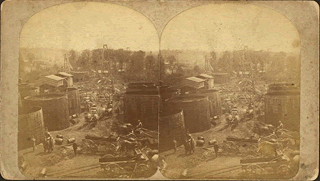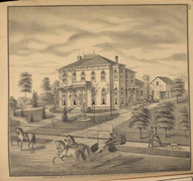Thomas Holmden 1818 - 1886
Sarah Holmden 1818 - 1870
From Rags to Riches
Thomas Holmden’s father, Walter, was born in 1788 in England and was an ordained Baptist minister. His mother, Sarah, was born in 1788 and married Walter in 1814. The Holmdens had five children, Thomas, Sarah, Elizabeth, Walter and John. The emigrated to the US in 1824 and by 1837 had settled on a 650 acre tract of land in Cornplanter Township, Venango County, Pennsylvania. The land straddled two creeks, Big Pithole Creek and Little Pithole Creek. The land was so poor that the company who sold it to Walter gave him an extra 100 acres just to make the deal happen. Walter died in 1849 and the brothers split the land between them. The soil was so poor the Holmdens lived in poverty depending more on their rifles and products of the forest than they did their farmland. In 1849 John Holmden died.
It was 1859 that oil was discovered about six miles north of the Holmden property. In 1864 Thomas and his brother Walter leased a portion of their land to James Faulkner of Kings County, New York, who gave them each $1.00 and promised that if oil was found the Holmdens would receive one-fourth of the oil produced. Faulkner and his partners formed the United States Petroleum Company and in June 1864 they began drilling on the Holmden property. On January 7, 1865 at six hundred feet down the well came in, flowing at 650 barrels per day. On January 20 Thomas sold his 159 acre farm for $100,000 which today would be about $1,420,000.

When John Holmden died Thomas became guardian of his children. When oil was struck Thomas sold John’s farm for $75,000, investing $25,000 of it in US bonds for John’s children.
In May of 1865 the town of Pithole City began to spring up on the Holmden property and by the middle of July had a population of 2,000 persons. The US government opened a post office there which soon became the largest in the state of Pennsylvania. By September the population had grown to 15,000 and by Christmas, 20,000. At its peak Pithole City had 54 hotels, 3 churches, a newspaper, an 1,100 seat theater, a railroad, the world’s first pipeline and a redlight district not unlike Dodge City’s.

By the end of 1865 oil production had dropped off substantially and in March 1866 a chain of banks collapsed which triggered a financial panic throughout the oil region. When many oil strikes occurred elsewhere in Venango County people left Pithole City. By December 1866 the population had dropped to 2,000 and very quickly after that Pithole City became a ghost town.
Thomas and Sarah Holmden left Pithole City in 1866 moving to Cleveland, Ohio where they purchased land along Scranton Avenue with the intentions of farming. After a while Thomas decided to sell the property and developed it into a residential neighborhood. They lived on Scranton Avenue in a large house that was featured in the 1874 Atlas of Cuyahoga County. Thomas, a republican, became involved in politics serving as a city councilman in Ward 12 for many years and as a member of the Infirmary Committee of city council. His term on the committee saw the construction of a new facility for the “incurable insane.” Sarah died in 1870 and Thomas married Jerusha Mackey, who was many years younger than him, in 1871.
Thomas Holmden was a friend to many and when he died in 1886 the minister’s eulogy said, “During his long and honorable life he was repeatedly called upon to fill positions of trust, and the confidence of his neighbors is best illustrated by the fact they selected him to represent them in the municipal government . . . he was of a kind-hearted, benevolent and charitable disposition and of a rare genial nature. He will be greatly missed. We need many more such as he was.”
